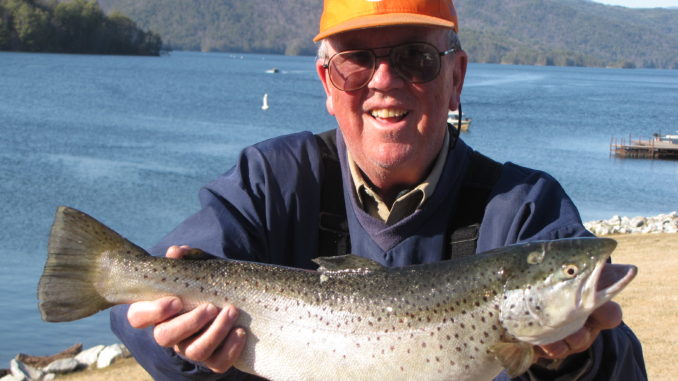
When the water gets cold, trolling for big trout takes center stage on this mountain reservoir.
Lake Jocassee is a mountain lake located in the northwestern corner of the state, split between Oconee and Pickens counties, its headwaters across the North Carolina line.
If you are looking for something to do between the end of deer season and the opening of turkey season, Lake Jocassee is THE place to catch some fine brown or rainbow trout — if you do not mind cold weather.
Fishermen catch these trout using many different techniques, but Ed Reeves of Spartanburg, a constant threat to win tournaments on Jocassee, likes trolling the best.
Reeves is one of the “old timers” who started fishing Lake Jocassee back in 1988. Around 2000, he began fishing with Larry Essex, one of the premier Jocassee fishermen who had won many trout tournaments. This dynamic duo fished together for many years until Essex sold Reeves his boat and moved away.
Now retired, Reeves has won eight trout tournaments on Jocassee since 2004, events held from the end of November through mid-April, beginning at 8 a.m. and finishing at 4 p.m. Obviously, he must know something about fishing for trout during the day.
Toward the end of December, Reeves likes to be fishing up in the lake’s tributary rivers — the Laurels Fork, Horsepasture, and Toxaway — but this all depends on what the baitfish are doing.
“As the water starts to get colder, around 50 degrees, the trout will start to move out of the rivers into the big water in search of food: threadfin shad or blueback herring,” Reeves said. “Where ever you find the baitfish is where you will find the trout.”
According to Dan Rankin, a fisheries biologist for the S.C. Department of Natural Resources, brown trout will make a big move back into the lake.
“The Jocassee trout fishery is supported exclusively by stocking, and because brown trout are fall spawners, some of the larger, mature browns in Jocassee will attempt to ascend tributary streams during spawning season,” he said. “After these spawning attempts, brown trout will be hungry. The rivers do not have the available forage the larger brown trout are accustomed to in the lake, and the fish will likely be feeding aggressively when they return back to the lake from the streams.”
A good depthfinder is essential in locating the baitfish. Reeves will cruise the lake, using his depth sounder to look for baitfish. It will not only show the location of the baitfish and the trout, but also any relevant structure. The key is to have your lures running slightly above the level at which the trout are feeding. But even if fish are located and lures and/or bait are offered correctly, there is no guarantee that the trout will hit.
“If the trout are hungry and feeding, they will hit almost anything that comes their way. If not, you can not make them bite,” Reeves said.
Trolling for trout can involve using leadcore line, side planers, dragging deep-running lures or just casting out a bait that’s heavily weighted; Reeves prefers using downriggers. Having his boat equipped with electric downriggers makes it easier for him to fish by himself, and it’s easier to get the lures up if you start to run over a sunken island or trees.
Trolling depths from December through February range from surface to 50 feet. The trout will usually “stack up” at certain levels depending on the water temperatures. By fishing at different depths, your odds are increased. An example of Reeves’ trolling pattern is to have lures at 35, 40, 45 and 50 feet, but this may be adjusted according to what the trout want that day.
Reeves prefers to fish two downriggers with two rods per downrigger in what is called a “double stack.” Each rod is set with a different lure and fished a various depths, usually at 5- to 10-foot intervals. The rods on the port downrigger are set at 50 and 40 feet deep and the starboard downrigger rods are set at 45 and 35 feet — depending on where the depthfinder shows the bait and where the trout are holding.
The most commonly used lures are spoons, spinners and imitation-shad lures. Reeves’ favorite tournament winners include: Apex trolling lures, Yo-zuri Pin Minnows, and old type Flatfish or Lazy Ikes. Sutton Spoon — a favorite for Reeves and other Jocassee fishermen for many years — are difficult to find with the manufacturer out of business. Reeves’ main colors include white, silver and yellow, but black and red can work, too.
“More important than the color is the size,” he said. “In late summer and in early fall, when the fish are down deep (80 to 100 feet), big lures from three to five inches long or more are effective. When the trout come into shallower water in the winter, they prefer smaller lures from one to three inches long.”
To avoid line twist, Reeves uses size 0 stainley-steel ball-bearing snap swivels — not to be confused with the cheaper snaps that do nothing to help with line twist.
When Reeves uses a double stack, he will generally fish a lure on top and a minnow on bottom. He likes a 2- to 4-inch minnow fished with a No. 2 octopus hook with a No. 12 treble as a stinger hook in the bait’s tail. Reeves said that catches more than half of his fish on the stinger hook.
Reeves matches 7-foot fiberglass rods with medium-size spinning reels. These rods pop up when a fish hits and releases the line from the downrigger clip. Reels must have a good drag system, because they’re spooled with 4- to 6-pound line because of Jocassee’s extremely clear water. Also, lighter line gives the lure more action, and chances of fooling a large fish into striking are improved. Reeves likes to fish 4-pound test Maxima line.
Trolling involves many hours of cruising the lake, trying to locate a school of threadfin shad, the trout’s major food source. The trolling speeds can vary, but basically, 1.1 – 1.2 mph is the standard. If the boat has a big outboard motor, a smaller “kicker” motor is most-often used. Reeves uses a system that attaches the big motor to the “kicker” so he can use his steering wheel to control the boat.
If the boat has a big motor but no kicker, a trolling plate can be placed to slow the speed down. A simpler version is to drag a 5-gallon bucket or a drift sock behind the boat. Zig-zagging, stopping, and starting are employed to change speeds. Only by varying the pattern can on tell what the trout will hit on a given day.
Reeves has spent many hours on Jocassee perfecting his craft of catching trout from the lake, but the fact is, Jocassee fishermen do not need an expensive boat with all kinds of fancy electronics and equipment to catch large trout.
Larry Edwards of Pickens caught the state-record brown trout, a 17-pound, 9½-ounce fish, from the bank. Edwards is no stranger to catching big; he fishes large, live minnows hooked through the tail just behind the dorsal fin. He makes a cast from the bank and allows the minnows to swim, unencumbered by any weight.
Winter is prime time for Jocassee trout because they are closer to the surface, and because the bigger fish start to show up around Christmas as the weather really cools. Make no mistake about it, fishing Jocassee is not for warm-weather anglers. Specialized, heavy duty clothing must be warn to stay warm; numb fingers and frozen toes are the norm. With the best fishing being 24 to 48 hours before an approaching storm hits, you have to be ready for bad weather. It only take 15 minutes from the time you see a storm coming over the mountain until it is on top of you, so you have to be prepared.
DESTINATION INFORMATION
HOW TO GET THERE — Lake Jocassee is a deep, crystal-claer mountain lake covering 7,500 acres, with 75 miles of basically undeveloped shoreline. It is in the upper end of Pickens and Oconee counties, with its headwaters largely rising across the state line in North Carolina. The best way to reach the lake is on SC 11, which can be accessed from I-85 of I-26. From SC 11, go north on Lake Jocassee Rd. approximately three miles. The only public boat ramp is in Devils Fork State Park.
WHEN TO GO — Brown trout finish spawning late in the fall and drop back out of tributary streams and rivers into the main body of the lake in late December. Fishing is excellent into March.
TECHNIQUES — Trolling with downriggers, leadcore line or side planers is the preferred method of presenting live baits or lures to trout anywhere from 30 to 50 feet deep during the winter. Use 7-foot fiberglass rods with a soft action, matched with spinning reels spooled with 4- to 6-pound test mono. Barrel swivels should be used to avoid line twist.
TROUT REGULATIONS — On Lake Jocassee, the daily creel limit is five trout, with a 15-inch size minimum. Only artificial lures and bait can be used; no corn, cheese, fish eggs or imitations are allowed. All non-game devices are prohibited, including casts nets.
FISHING INFO/GUIDES — Sam Jones, Jocassee Charters, 864-280-9056; James Couch, 864-982-1016. Jocassee Outdoor Center, 516 Jocassee Lake Rd . Salem, 29676-2206, 864-944-9016.
ACCOMMODATIONS — Devils Fork State Park has campsites and cabins for rent. Call 864-944-2639, 866-345-7275 or email devilsfork@scprt.com. The Walhalla Motel, 901 E Main St., Walhalla, 29691, 864-638-2585 is the closest motel.
MAPS — Kingfisher Maps, 110 Liberty Drive Clemson, 29631, 800-326-0257, http://www.kfmaps.com/.

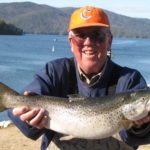
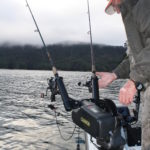
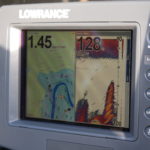
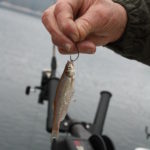
Be the first to comment